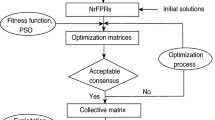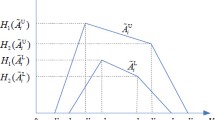Abstract
The prametric is an ‘almost metric’ which does not necessarily satisfy the triangle inequality but able to describe the consensus intransitivity in group decision making (GDM) such as Tom and Jack have preferences in common, also Jack and John have preferences in common, but, Tom and John do not necessarily have preferences in common. A prametric-based consensus formation procedure for GDM was presented in a literature. This paper considers the procedure under fuzzy environment where the individuals’ preferences are provided as fuzzy numbers. The Yager defuzzification method is used for constructing the preference sequence matrix where the (i, j)-th entry indicates the alternative i’s position(s) assigned by individual j. An illustrative example for application is also included.
Similar content being viewed by others
References
Armstrong RD, Cook WD, Seiford LM (1982) Priority ranking and consensus formation: the case of ties. Manag Sci 28(6):638–645
Arrow KJ (1951) Social choice and individual values. Wiley, New York
Bellman RE, Zadeh LA (1970) Decision-making in a fuzzy environment. Manag Sci 17(4):141–164
Bortolan G, Degani R (1985) A review of some methods for ranking fuzzy subsets. Fuzzy Sets Syst 15(1):1–19
Cádenas E, Castillo JC, Cordón O, Herrera F, Peregrín A (1994) Influence of fuzzy implication functions and defuzzification methods in fuzzy control. Busefal 57:69–79
Chandramohan A, Rao MVC, Arumugam MS (2006) Two new and useful defuzzification methods based on root mean square value. Soft Comput 10:1047–1059
Cook WD, Kress M, Seiford LM (1997) A general framework for distance-based consensus in ordinal ranking models. Eur J Oper Res 96(2):392–397
Cook WD, Seiford LM (1978) Priority ranking and consensus formation. Manag Sci 24(16):1721–1732
Cordón O, Herrera F, Márquez FA, Peregrín A (2004) A study on the evolutionary adaptive defuzzification methods in fuzzy modeling. Int J Hybrid Intell Syst 1(1):36–48
Deng H, Yeh CH (2006) Simulation-based evaluation of defuzzification-based approaches to fuzzy multiattribute decision making. IEEE Trans Syst Man Cybern A 36:968–977
Detyniecki M, Yager RR (2000) Ranking fuzzy numbers using \(\alpha \)-weighted valuations. Int J Uncertain Fuzziness 8(5):573–591
Driankov D, Hellendorn H, Reinfrank M (1993) An introduction to fuzzy control. Springer, Berlin
Dubois D, Prade H (1978) Operations on fuzzy numbers. lnt J Syst Sci 9(6):613–626
Dyer JS, Sarin RK (1979) Group preference aggregation rules based on strength of preference. Manag Sci 25(9):822–832
Facchinetti G, Ricci RG (2004) A characterization of a general class of ranking functions on triangular fuzzy numbers. Fuzzy Sets Syst 146(2):297–312
Facchinetti G, Ricci RG, Muzzioli S (1998) Note on ranking fuzzy triangular numbers. Int J Intell Syst 13(7):613–622
Figueiredo M, Gomide F, Rocha A, Yager R (1993) Comparison of Yager’s level set method for fuzzy logic control with Mamdani’s and Larsen’s methods. IEEE Trans Fuzzy Syst 1(2):156–159
Filev DP, Yager RR (1991) A generalized defuzzification method via bad distributions. Int J Intell Syst 6(7):687–697
Fishburn PC (1977) Condorcet social choice functions. SIAM J Appl Math 33(3):469–489
Gavshin Y, Kruusmaa M (2008) Comparative experiments on the emergence of safe behaviours. In: TAROS, pp 65–71
Gibbard A (1973) Manipulation of voting schemes: a general result. Econometrica 41(4):587–601
Greenfield S, Chiclana F, Coupland S, John R (2009) The collapsing method of defuzzification for discretised interval type-2 fuzzy sets. Inf Sci 179(13):2055–2069
Greenfield S, Chiclana F (2013) Accuracy and complexity evaluation of defuzzification strategies for the discretised interval type-2 fuzzy set. Int J Approx Reason 54:1013–1033
Hou J (2015) A consensus gap indicator and its application to group decision making. Group Decis Negot 24(3):415–428
Inuma M, Otsuka A, Imai H (2009) Theoretical framework for constructing matching algorithms in biometric authentication systems. In: Proceedings of ICB09, Alghero, Italy. Lecture notes in computer science, 5558, Springer, Berlin, pp 806–815
Kacprzyk J, Fedrizzi M (1990) Multiperson decision making models using fuzzy sets and possibility theory. Kluwer Academic Pub, Dordrecht
Keeney RL (2013) Foundations for group decision analysis. Decis Anal 10(2):103–120
Kemeny JG (1959) Mathematics without numbers. Daedalus 88(4):577–591
Kichert WJM (1978) Fuzzy theories on decision making. Nijhoff, Leiden
May KO (1953) A note on the complete independence of the conditions for simple majority decision. Econometrica 21:172–173
Moulin H (1985) Choice functions over a finite set: a summary. Soc Choice Welf 2(2):147–160
Patel AV, Mohan BM (2002) Some numerical aspects of center of area defuzzification method. Fuzzy Set Syst 132:401–409
Rao DH, Saraf SS (1995) Study of defuzzification methods of fuzzy logic controller for speed control of a DC motor. In: Proceedings of the 1996 international conference on power electronics, drives and energy systems for industrial growth, 1996. IEEE, vol 2, pp 782–787
Roychowdhury S, Pedrycz W (2001) A survey of defuzzification strategies. Int J Intell Syst 16(6):679–695
Runkler TA (1997) Selection of appropriate defuzzification methods using application specific properties. IEEE Trans Fuzzy Syst 5(1):72–79
Runkler TA (2013) Kernel based defuzzification. In: Moewes C, Nürnberger A (eds) Computational intelligence in intelligent data analysis. Springer, Berlin, pp 61–72
Saneifard R (2015) Another method for defuzzification based on signal/noise ratios and its applications in comparing DMUs. Commun Adv Comput Sci Appl 1:32–36
Satterthwaite MA (1975) Strategy-proofness and Arrow’s conditions: existence and correspondence theorems for voting procedures and social welfare functions. J Econ Theory 10:187–217
Skala MA (2008) Aspects of metric spaces in computation. Ph.D. thesis, University of Waterloo, Ontario, Canada, p 2
Slater P (1961) Inconsistencies in a schedule of paired comparisons. Biometrica 48:303–312
Typke R, Walczak-Typke A (2010) Indexing techniques for non-metric music dissimilarity measures. Advances in music information retrieval. Springer, Berlin
Van Broekhoven E, De Baets B (2004) A comparison of three methods for computing the center of gravity defuzzification. IEEE Int Conf Fuzzy Syst 3(1):1537–1542
Van Leekwijck W, Kerre E (1999) Defuzzification: criteria and classification. Fuzzy Set Syst 108(2):159–178
Wang YM (2009) Centroid defuzzification and the maximizing set and minimizing set ranking based on alpha level sets. Comput Ind Eng 57:228–236
Wang X, Kerre EE (2001) Reasonable properties for the ordering of fuzzy quantities (I). Fuzzy Set Syst 118(3):375–385
Wang X, Kerre EE (2001) Reasonable properties for the ordering of fuzzy quantities (II). Fuzzy Set Syst 118(3):387–405
Wierman MJ (1997) Central values of fuzzy numbers—defuzzification. Inf Sci 100(1):207–215
Yager RR (1981) A procedure for ordering fuzzy subsets of the unit interval. Inf Sci 24(2):143–161
Yager RR, Filev D (1993) On the issue of defuzzification and selection based on a fuzzy set. Fuzzy Set Syst 55(3):255–271
Yager RR, Filev D (1999) On ranking fuzzy numbers using valuations. Int J Intell Syst 14(12):1249–1268
Yager RR (2013) Pythagorean fuzzy subsets. IFSA World congress and NAFIPS annual meeting (IFSA/NAFIPS), 2013 Joint. IEEE, pp 57–61
Zadeh LA (1965) Fuzzy sets. Inf Control 8:338–353
Acknowledgments
The author would like to thank the Editor-in-Chief, the Associate Editor and the anonymous Referees for their helpful comments and suggestions. The work was supported by the National Natural Science Foundation of China (No. 71571019).
Author information
Authors and Affiliations
Corresponding author
Rights and permissions
About this article
Cite this article
Hou, F. The Prametric-Based GDM Procedure Under Fuzzy Environment. Group Decis Negot 25, 1071–1084 (2016). https://doi.org/10.1007/s10726-015-9468-0
Published:
Issue Date:
DOI: https://doi.org/10.1007/s10726-015-9468-0




